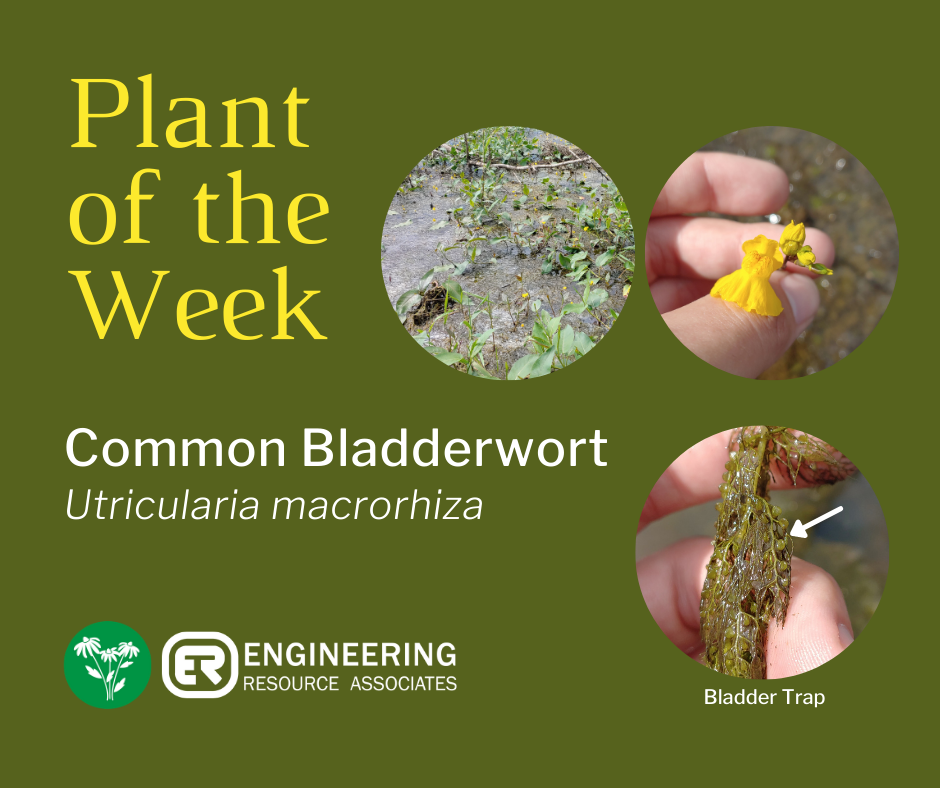This week’s plant is Utricularia macrorhiza, or the Common Bladderwort.
Utricularia is a highly specialized group of plants that can be found across the globe and can range widely in habitat from floating in stagnant bogs, nestled in moss on mountaintops, and climbing trees in rainforest canopies. What sets these plants apart from others is that they have adapted to grow in nutrient-poor environments and have since devised a way to supplement their intake of nitrogen and phosphorous by digesting micro-invertebrates such as nymph-stage insect larva. While there are several insectivorous plants, like Pitcher Plants, Sundews, and the famous Venus Flytrap; Utricularia, or Bladderwort, trap prey using one of many small bladders located along its root structures that have fine hairs surrounding a lidded opening. When a small organism brushes these hairs, the trap springs open with such force that it causes a vacuum, sucking the prey inside and closing the lid. That’s right! This is one of Illinois’ few native insectivorous plants.
Common Bladderwort can be found throughout Illinois in sunny stagnant water and is normally only observed when the bright yellow flowerheads poke up through the surface in the summer, otherwise it may be confused for pond scum, algae, or other less exciting pond weed. While some species in the Utricularia genus are terrestrial (living on the ground) and some are arboreal (living in trees or rock faces off the ground), this species is fully aquatic. It can be easily separated from other aquatic plants by the round bubbly traps spread among the fine moss-like foliage that float just below the water’s surface.
Here is a link to a video of the trap in action: https://youtu.be/Zb_SLZFsMyQ?t=50
Utricularia is a highly specialized group of plants that can be found across the globe and can range widely in habitat from floating in stagnant bogs, nestled in moss on mountaintops, and climbing trees in rainforest canopies. What sets these plants apart from others is that they have adapted to grow in nutrient-poor environments and have since devised a way to supplement their intake of nitrogen and phosphorous by digesting micro-invertebrates such as nymph-stage insect larva. While there are several insectivorous plants, like Pitcher Plants, Sundews, and the famous Venus Flytrap; Utricularia, or Bladderwort, trap prey using one of many small bladders located along its root structures that have fine hairs surrounding a lidded opening. When a small organism brushes these hairs, the trap springs open with such force that it causes a vacuum, sucking the prey inside and closing the lid. That’s right! This is one of Illinois’ few native insectivorous plants.
Common Bladderwort can be found throughout Illinois in sunny stagnant water and is normally only observed when the bright yellow flowerheads poke up through the surface in the summer, otherwise it may be confused for pond scum, algae, or other less exciting pond weed. While some species in the Utricularia genus are terrestrial (living on the ground) and some are arboreal (living in trees or rock faces off the ground), this species is fully aquatic. It can be easily separated from other aquatic plants by the round bubbly traps spread among the fine moss-like foliage that float just below the water’s surface.
Here is a link to a video of the trap in action: https://youtu.be/Zb_SLZFsMyQ?t=50

